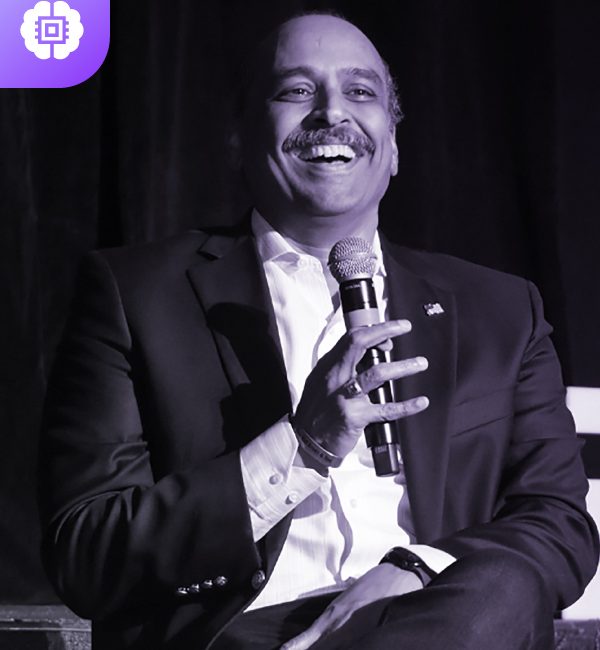
Tackling Retail’s Inventory Problem: The INTURN promise
About this Podcast:
As a leader in supply chain visibility, New York-based INTURN provides enterprise consumer brands with a system of record to manage and optimize slow-moving or excess inventory. The solution gives retailers the tools to centralize data, streamline workflows, gain supply chain visibility and meet their sustainability goals.
Combining Inturn’s inventory workflow tools and margin optimization capabilities together with Vue.ai’s retail AI suite, customers now get the power to not only effectively use AI to optimize supply chain processes and planning but also weave it into customer experiences to create efficiencies across the entire retail value chain.
Listen on:
Episode Transcript:
Krithika Anand
Hi, and welcome to a brand new episode of the retail podcast. I'm your host Krithika Anand and joining me today is Ashwani Ashokan, CEO and founder of Vue.ai. This is a little close to our hearts. Before I tell you who our guests, let me begin by saying what an incredible year 2022 was. We were certainly not short of announcements and excitement at the video headquarters. But truly, the undoubted cherry on top was INTURN’s additions to the street and family. As a leader in the supply chain, visibility, New York based engine provides enterprise consumer brands with a system of record to manage and optimize slow moving and excess inventory. The solution gives retailers the tools to centralize data, streamline workflows, gain supply chain visibility and meet their sustainability goals. Our guest today is Ronen Lazar, the founder of Inturn. It's lovely to have you on a podcast today.
Ronen Lazar
Hi, Krithika. Hi, Ashwini. It's really great to be here.
Krithika Anand
Welcome to our podcast. Lots of exciting things coming up our way in this conversation. So let's jump right in. Over to you, Ashwini.
Ashwini Asokan
All right. Hey, Ronen, wonderful to have you with us on this podcast. I was actually hoping to start right at the top. Why did you start the company?
Ronen Lazar
It's a great question. We were exposed to lots of inventory that saw some really interesting pricing with very broad delta between interest across consumers. And as we saw this data coming out of some of the original pilots that we ran, we decided that we needed to have a deeper look into why this inventory exists to begin with and how the consumer brands actually look to price this inventory. And as we look deeper and peel back the layers of the onion, we recognize that there's actually no system whatsoever that helps consumer brands gain visibility into excess inventory and more importantly, no system that helps them manage and optimize this inventory. So, you know, historically, companies would output data into Microsoft Excel files if they were selling it B2B to third parties. Many would look to mark goods down and sell goods to their own consumers. It was a little bit of the Wild West, and so we decided to form Inturn and solve this problem.
Ashwini Asokan
It almost feels like. 2023. Coming up, everything feels a bit like doomsday. I don't know that you can walk on the streets without, I don't know, escaping any conversation about all the impending doom. But interestingly, it feels like now is the time in so many ways for all things excess inventory, Right. Retailers seem to have and I've heard you say this before, which is, you know, there have been times where people are like, ah, it's not really a problem versus the narrative now, which is we've actually seen stocks kind of plummeting because of this one single point across the country in the US. And so why does 2023 feel a bit like the year of excess inventory?
Ronen Lazar
Yeah. I mean, it's interesting. If you look back over the last century or so, there's been no storm as perfect as this one as it relates to excess inventory. And maybe just to take it back for a moment. Excess inventory, it's a factor. Every single business, you know, planners do their best to forecast what demand might exist in the market. And there's a plethora of reasons why inventory might remain unsold. In many cases, the inventory is classified as slow moving, in which case there's plenty of lifespan to that inventory. But it's tying up working capital, it's tying up capacity, and those need to be resolved in order to free up cash and capacity for the incoming inventory. And then in some cases, whether it be fashion nearing the end of the season or whether it be CPG actually with a hard expiration date, inventory is truly excess, in which case many of the retailers who would typically consume this inventory just don't want it. And in either scenario, the historical nature and way that this inventory was managed was pretty much as an afterthought, right? It was a very reactive mindset and at that point it becomes a fire drill. So if you look at under normal business conditions, this is a very important part of the business coming out of COVID with all the inventory volatility that as consumers we're familiar with. One month there was inventory sold out, the next month there was too much inventory with that type of environment. A lot of companies who manufactured goods overseas double, triple, quadruple ordered inventory sourced from different countries, not knowing where inventory might surface from. And that was due to the supply chain disruption. Companies who manufacture closer to home simply did not know what to have in terms of volume, where and when, and for who. Because the volatility translated into unpredictability around consumption patterns in general. Part of the challenge, I think, is order signals really drive whether or not companies ramp up production or not. And as part of that, with this type of volatility where you have one month consumption pattern spike and then the next month come down. That creates some really interesting challenges for virtually any company.
Ashwini Asokan
I mean, I think in the last couple of weeks, as we've been talking to all of our, you know, customers as well. Together, our teams, I guess, at this point. There definitely seems to be a little bit of a hole. 2021 was amazing and, you know, everyone was out there partying and so we ended up thinking this is going to be more of this. And then we ended up buying more. And it definitely feels like, you know, it's going to take another 12 to 18 months for things to even begin. Like, I think evening out. Right. I think we've heard this from so many brands in the last say, you know, a couple of months specifically. Right. But I want to go back. I think as you were talking, you were talking about discounted, you know, goods. You were talking about expired goods, you were talking about international. It just feels like there are so many channels, Right. So it doesn't feel like a one use case kind of a thing. It feels like, you know, excess inventory itself seems to have so many different channels and use cases. Can you just walk us through some of those?
Ronen Lazar
Absolutely. So, you know, when inventory surfaces, the companies that own this inventory need to be super careful about where they sell this inventory. And in different parts of the world, there's different affinity towards different channels. Sometimes offline is kind of the key. Other times there's more flexibility to sell online and Europe is perhaps a great example of that. And when selling goods into this to this market, companies sometimes have their own channels. There could be their own clearance or outlet stores where a lot of times the goods are made for those stores, but then they supplement that inventory with excess inventory, in which case it's sold through that channel. The other format is to sell goods to third parties, and that's where it really becomes interesting, that secondary market, you know, we're all familiar with major off producers who have grown like crazy over the last since 2007, eight, even from before. And those retailers have become a home for this surplus inventory for inventory that's, again, either slow moving or excess and have made a really solid business out of turning that around and selling it to consumers. There are alternate channels that companies have started selling goods into. And, you know, this is a byproduct of getting ahead of it. This is a byproduct of perhaps being more proactive than reactive to the goods that surface and pile up. There's alternate channels. And whether that's an alternate geography or whether that's more of an emerging markets retailer or even in some cases, full price retailers buying goods at less discount that might be sold into these off pricers. You know, it's interesting. As consumers, we've been trained to think about discounts and expect discounts, and that's part of the challenge. A few years ago, I was interviewed by a publication and they said, Can you explain off price? And I said, Well, our price, you know, it's 40 to 90 off every day. And they quickly responded and said, well, isn't that every retailer today? And it's fascinating how as consumers, it's something that we've come to expect.
Ashwini Asokan
Are there specific types or categories of goods that this is more? Are you seeing this more with like or are they behaving differently like how CPG are responding to this versus like fashion apparel? Are you are you beginning to see either channels being different or like behavior being different?
Ronen Lazar
Yeah, it's a great question. Truthfully speaking, this type of excess inventory exists across every category, whether consumer or not. And in some cases, it could be raw materials, it could be partially processed goods, and it could be finished goods. We, as intern have always focused on consumer categories. And in those categories you run the gamut from fashion and apparel to food and beverage, health and beauty, personal care, electronics, home. And again, going back to my comment earlier, when goods are manufactured overseas, inherently there's lead time. And so it's not as fast moving as perhaps food and beverage or personal care where goods are categorized as fast moving consumer goods in either scenario. The levels of inventory have been completely out of whack. From a INTURN perspective, the capability that we've built really allows each of these companies to gain visibility. So one is to understand what they're dealing with at any moment. That becomes very real time in nature. And then beyond that, to optimize for both time for speed and for value to ensure that the goods can be sold quickly, easily, and ensure that they're gaining the right margin return as a result.
Ashwini Asokan
You talk about capabilities. I almost want to just just turn around a little bit into that that zone here and almost look at INTURN the product. Right. One of the reasons, obviously, we got so excited when we got to know you guys is the problem space definitely felt very real. And, you know, sometimes it's also a timing thing. Right. And I've heard you say this before, but, you know, market cycles, counter cycles, like we just really have to and it just really feels like, you know, the next decade is so much about rethinking production. Manufacturing demand for like this really is the space. But if and it's definitely one of the the the things that got us super excited. But the other thing that made us kind of. Go. This is right for us to come together with the product itself. And I just want to kind of dig in that into the product a bit. What do you think, INTURN the product did given all this this all these problems everyone was facing, given all these different channels and all these different types of brands as well as, you know, the retailers that you're bringing that you're onboarding into the system, right? So it's definitely like a double sided thing where you've got the brands buying this and then they work with the retailers to kind of onboard them. If you have to look at the product through both lenses, like just tell me what about this product is like the most? Love the set of core features. Right. What is it that the power users are doing? What is the primary value proposition? What are some of the key features in there that allow this problem to actually go away?
Ronen Lazar
Well, I mean, for starters, the problem never actually goes away. It just is able to be handled in a far more intelligent and beneficial way. But just looking at the two sides of the equation, historically, this was all managed in a very manual way. So there's INTURN does not replace an existing system and effectively replaces manual behavior with Excel spreadsheets. And so being that the real time nature of inventory availability is key, I would say that sits at the foundation of what intern is intern is able to aggregate all the relevant data around all available inventory, that slob that's moving or obsolete and aggregated in one spot so that the teams have visibility. And then with that visibility, looking at a layer of workflow tools that allow companies and the people who work in it to avoid busy work and ensure that they can get from point A to point Z in a far more, far more quick manner, starting with building assortments, allocating goods into different markets, pricing the goods, analyzing margins, and then of course, sending out the relevant offers to their counterparties. These are all critical aspects of the business, and doing so manually not just creates a far slower process, but the error prone aspects of just having data sitting in Excel spreadsheets while the goods could be sold elsewhere is highly problematic. It leads to overselling, and that's something that we've heard virtually from every customer has been a challenge, and that's something the Internet clearly solves. We've not had one situation where goods were oversold since inception. On the other side of the equation, you've got buyers who really thrive off of time. Time is critical, especially if there's an open to buy situation. If a company has a set of funds that they're looking to source goods with, speed is critical as well as just speed throughout the season. And so being able to access goods quickly is key. In addition to that, since the interim platform allows our brand partners to master the data and attach images to it very efficiently, that's something that's key and critical. I mean, we've heard from so many buyers that their junior buyers historically had to sit there Googling style numbers and looking to understand what it is that sits in that spreadsheet and whether or not.
Ashwini Asokan
It blows my mind away. Right. And I and I heard this, I mean, making the rounds with you guys and it just blows your mind away because you're going and this is not the I mean, we've encountered this from when we were selling things like tagging as well, right? On the product tagging side of things. We've had companies coming and telling us like, you know, in the buying and merchandising side, you have people that are literally looking at this and then going and looking it up elsewhere in a very adjacent use cases, not the exact same thing, but then the action of the number of times in in their jobs, you know, they have to go out there and search for something and then pull it up to compare it with what they're doing inside their own business. Just feels like what? How is this remarkable? Like, how is this? It's 20, 23 and in so many ways, I think. You know, and as a company that that's all about the big A.I. platform story and about all things generalizable intelligence. You are humbled in so many ways by the fact that this is the problem. Like this is the problem. And and we see this kind of repetitive almost. Across industries, whether it's retail or it's, you know, I don't know pharma. We were just on a call last night or in this space of like health care. Like you actually squint and see. And the problem that really large enterprises are trying to solve for are as mundane and ridiculous as this one that you're just pointing out. Right. And we say ridiculous because it just feels unrealistic. I mean, you're talking about, you know, I don't know, like, really crazy tech. And then on the other hand, you're talking about the reality of what it takes to really build businesses. And these are fantastic enterprises. These are not random. These are Fortune 5000, Fortune 24,000 companies that we're talking about. But these problems are real. Right. And it's almost like you have crud that's built up in a 50 plus year old organization. And there's all kinds of practices. And, you know, it just starts to add up at some level. But then I think from a product standpoint, it's amazing how much relief like a simple feature can can provide to time cost money or why. Everything. Right. And it's that's that's just absolutely mind blowing I think.
Ronen Lazar
Yeah, yeah, yeah. It's interesting. You know, a lot of times when companies focus on innovation, they focus on the shiny, exciting objects and, you know, sometimes forget some of the simple tasks that their team is doing and how long and how much is costing them. And that's why we've developed our workshop. When we onboard each customer, we run this workshop with the organizations to understand people, processes, systems, what is everyone doing, How frequently, why are they doing it? To really just transform the way that they think about their day to day function as it relates to this inventory and of course, to make them move faster and of course to have them think differently about the business. So in a strange, roundabout way, you're absolutely right. It's you know, this is this is critical and it's so basic and really guiding their hands has really yielded tremendous ROI as a result.
Ashwini Asokan
I'll flip that whole let's go to the other end of the other extreme of this conversation, which is I think, you know, we were discussing about how with Vue.ai you're talking about inventory coming inside, merchandize being tagged, organized and data being created or edited or just organize so that it can be consumed in downstream use cases. And then a set of productivity tools on styling and merchandising that allow them to function very similar to turn going into kind of the end to end personalization side of the story and then finishing off with what does it mean to deal with excess inventory. Right. And this is how the story of view and in turn kind of come together. But interestingly, I guess as we you and I have gotten talking and we've been talking with the customers as well, it feels like, hey, there's that actually there's a phase zero, right? Even before the goods come in and we start tagging it, there's a phase zero here, which is how do you actually decide what gets produced and what quantity. How do you forecast even before that journey really starts? Right. And so today, I think so much of this excitement of INTURN and Vue coming together, if it's about one end of the spectrum, I think there's the other end of the spectrum very much in there, which is how do we use our AI capabilities to help solve some of these problems even before they come and show up at the other end of the spectrum? Right. I think that definitely for us is a is a very exciting kind of almost roadmap of where we get to take this story. Any any thoughts on that?
Ronen Lazar
Absolutely. I mean, most companies think of their inventory through the lens of cause and effect. And so while in turn does a great job in solving the effect it exists, it's a problem. How do we clean up this problem and how do we do so in a very predictable way, instead of letting inventory build to get ahead of it and to solve the problem, many companies still struggle with the whole equation around cause why does this inventory exist all together? Right? And this goes back to the original steps of planning, manufacturing and logistics, and ensuring goods get to the right places at the right time and having the right volume available for replenishment, and then starting to look at the factors that guide the hand of the organization to determine whether they can hit the demand forecast that they originally set. And this could be weather patterns, it could be financial climate, it could be that the company made a garment in the wrong shade of gray. And of course, it could be a macro situation. Um, you know, whether it be recession, whether it be pandemic. So there's really there's any number of reasons that could really influence whether or not the company's hitting their targets or not. And that's what translates into slow moving and excess inventory. So to the extent that we can enable these organizations to start to understand in a far more predictable manner what is likely to become excess, that would help these companies just really identify the cause and then translate these goods into the interim pipeline?
Ashwini Asokan
I think there's also there's also the other end of that prediction, right. Which is just simply being able to analyze how different retailers have behaved across different seasons. Right. And then to say, here's how you allotted, here's how I think we heard that even recently on a on a customer call. Well, you know, folks, just stop the brand just talking about how one of the biggest things is, you know, you get to put up certain number of units for a particular retailer and you're like, just take the whole thing, right? Like, you don't want to go back and take some of it and then manage that whole thing as opposed to like, do it now and take this whole thing, right? So there's the timing piece of it, but there's also the whole if the predictive capabilities of our I can just help say no, like this is what you need to apportion to these people versus these people versus these. There's just so many nuances, I think all the way from macro to micro of every single retailer to be able to kind of say, yeah, all of this can be automated and predicted. You don't actually need a human looking through all of that data to make the decision. And from a timing perspective, you're talking about what could take 20, 30 days being done within a period of like a couple of minutes here, Right? And then the person basically going in and saying, I agree with this or I disagree with this because at the end of the day, I think the most important piece of this conversation is that the expertise is still with the people that are doing this job. And they have, what, 30 plus years of doing this? And what we want to be able to do is to make sure they get to have that final say. Right. Like that makes sense or that doesn't make sense. And to be able to kind of interpret the why real time, because they've seen those patterns before. Right. And so but remove that whole oh my God, I got to sit through all of this data and I got to figure out manually and keep all of that stuff in my head and hope and pray that I formed the right cause and effect kind of relationship there, removing that kind of unknown and providing the options for them to say that makes sense or that doesn't make sense, I think is where this whole thing is headed. And to be honest with you, this is one of the biggest pieces for me personally that really excites us about the team, about the journey and the road ahead. Thank you for taking the time to do this. And I think, you know, I wanted to get this done before the New Year so that we get to go out there with a bang in the New Year and get out there and say, like, here's a new chapter.
Ronen Lazar
It's my pleasure. It's great to have this conversation with you. And we're excited for the new year as well.
Krithika Anand
Thank you, Ronen and Ashwini, for this insightful conversation. I had a lot to take away from this, and I'm sure our listeners will too. The retail podcast by Vue.ai Has always pioneered conversations in all things retail and tech. In 2023, we're bringing you a lot more trailblazers who will dive deep into where retail is headed and what you need to watch out for. Until next time, I'm your host. Happy New Year and see you soon.
Meet your speakers:

Ronen Lazar
Vice President of Growth, US

Krithika Anand
Customer Marketing, Vue.ai

Ashwini Asokan
Founder & CEO, Vue.ai







